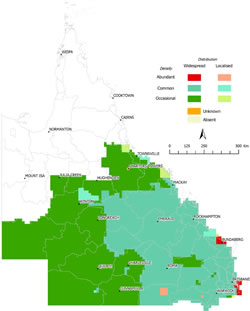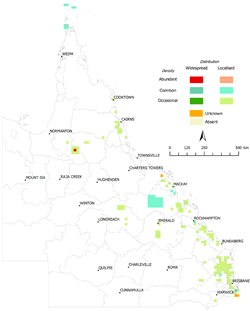
Invasive non-native terrestrial fauna species
You are viewing an archived copy of the 2017 report.
Key finding
Invasive non-native fauna species place significant pressure on Queensland’s native biodiversity through predation, competition for food and shelter, destruction of habitat, altering ecosystem balance, and poisoning.
Invasive non-native fauna species—introduced pest animals—place considerable pressure on Queensland’s native biodiversity. Negative environmental impacts include:
- predation on native fauna—foxes and feral cats have been implicated in the decline or extinction of native species
- destruction of habitats and natural resources including reduced water quality, increased soil erosion and land degradation, and destruction of native plants that provide food and shelter to native species
- competition with native animals for food and shelter
- disease, poisoning or injury to native animals—a decline of native predators has been attributed to poisoning from cane toads.
Some pest animals impact on specific habitats or species; others are more general and affect many species and ecosystems as well as ecological and physical processes. For example, feral rusa deer consume and damage native vegetation, disperse weed seeds and cause water fouling.
New pest animal introductions via the illegal pet trade or unknowingly, transported for example in cargo or fodder, continue to threaten Queensland’s environment. More than 20 pest animal detections have been made in recent years including ferrets, boa constrictors, American corn snakes, and an iguana.
More information:
Indicator: Invasive non-native fauna species
A selection of distributions of invasive non-native terrestrial fauna species from the Australian Pest Species Distribution Survey database. Data is current, ranging from 2012-2014.
-
 Distribution of fox (Vulpes vulpes), 2013–2014.
Source: Australian Pest Species Distribution Survey
Distribution of fox (Vulpes vulpes), 2013–2014.
Source: Australian Pest Species Distribution Survey
-
 Distribution of Rusa deer (Cervus timorensis), 2013–2014.
Source: Australian Pest Species Distribution Survey
Distribution of Rusa deer (Cervus timorensis), 2013–2014.
Source: Australian Pest Species Distribution Survey
- Previous Extent of endangered, of concern and no concern at present regional ecosystems
- Next Invasive non-native terrestrial flora species

